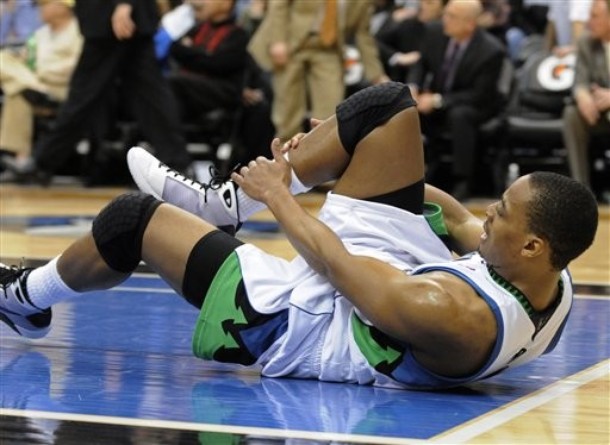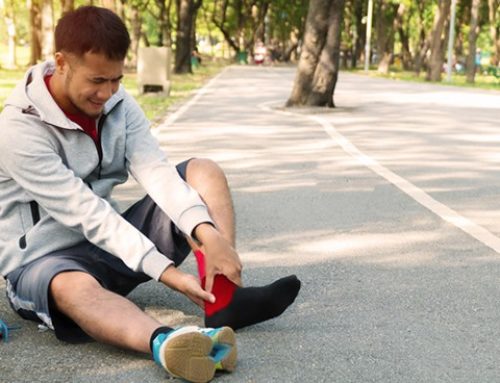How to Reduce Ankle Sprain Swelling

Ankle sprains are a common and painful injury among athletes. It’s important to take the proper steps to heal the injury so you can get back in the game as soon as possible. (See A Shoe That Prevents Ankle Sprains and Prolongs Your Career?)
Most people have heard of the RICE treatment—Rest, Ice, Compression, Elevation—but what exactly does it mean? Let’s take a look at these steps and hit on a few more things you can do to stop ankle swelling and speed up the recovery process.
Rest
This one is pretty obvious. Don’t do anything! The less physical stress you put on your ankle, the faster the ligaments and muscles will heal. Rest does not mean walk around and refrain from participating in practices and games. Rest means sit the couch, watchvsome TV and don’t do anything you don’t have to do. (Check out Washington Volleyball’s Take on Rest.)
Ice
Ice reduces ankle swelling by restricting blood flow. Standard protocol: 15 minutes of icing followed by 15 minutes of no ice; repeat as often as you like.
Do not place ice directly on your skin. It can burn you. Wrap the ice in a towel first. Or use a package of frozen veggies. I like frozen peas because they fit around the shape of your ankle to make full contact.
Compression
Wrap your ankle in a compression bandage to help reduce swelling. An ace bandage works fine, but you can also use a compression sleeve. Make the wrap tight enough to compress the ankle but not so tight that you cut off circulation. Don’t sleep in the wrap, but if necessary, use a nighttime compression sleeve.
Elevation
Keeping your foot elevated is another way to reduce blood flow and decrease swelling. This does not mean hanging out with your foot propped up on a recliner. Elevate your ankle above the level of your heart. Lying down with your foot up on pillows works fine.
More tips: wear loose-fitting shoes. You need proper support when walking, but when you’re at rest, loosen the shoe as much as you can or remove it altogether. Anti-inflammatory medication can also help reduce swelling and ease pain.
Once the ankle has healed, be patient about returning to normal activity and getting back in the game. As hard as it is for athletes to be patient (trust me, I know), if you return even a day too soon, your chances for re-injuring the ankle are high. When you do return, you might want to wear a brace for extra support and protection. (See Prevent or Rehab Ankle Sprains With These Strategies.)
Sources:
http://www.bupa.co.uk/individuals/health-information/directory/s/sprained-ankle
http://www.doctorsaputo.com/a/non-steroidal-anti-inflammatory-drugs-contraindicated-after-shoulder-surgery
http://adam.about.net/Images/19577.htm
RECOMMENDED FOR YOU
MOST POPULAR
How to Reduce Ankle Sprain Swelling

Ankle sprains are a common and painful injury among athletes. It’s important to take the proper steps to heal the injury so you can get back in the game as soon as possible. (See A Shoe That Prevents Ankle Sprains and Prolongs Your Career?)
Most people have heard of the RICE treatment—Rest, Ice, Compression, Elevation—but what exactly does it mean? Let’s take a look at these steps and hit on a few more things you can do to stop ankle swelling and speed up the recovery process.
Rest
This one is pretty obvious. Don’t do anything! The less physical stress you put on your ankle, the faster the ligaments and muscles will heal. Rest does not mean walk around and refrain from participating in practices and games. Rest means sit the couch, watchvsome TV and don’t do anything you don’t have to do. (Check out Washington Volleyball’s Take on Rest.)
Ice
Ice reduces ankle swelling by restricting blood flow. Standard protocol: 15 minutes of icing followed by 15 minutes of no ice; repeat as often as you like.
Do not place ice directly on your skin. It can burn you. Wrap the ice in a towel first. Or use a package of frozen veggies. I like frozen peas because they fit around the shape of your ankle to make full contact.
Compression
Wrap your ankle in a compression bandage to help reduce swelling. An ace bandage works fine, but you can also use a compression sleeve. Make the wrap tight enough to compress the ankle but not so tight that you cut off circulation. Don’t sleep in the wrap, but if necessary, use a nighttime compression sleeve.
Elevation
Keeping your foot elevated is another way to reduce blood flow and decrease swelling. This does not mean hanging out with your foot propped up on a recliner. Elevate your ankle above the level of your heart. Lying down with your foot up on pillows works fine.
More tips: wear loose-fitting shoes. You need proper support when walking, but when you’re at rest, loosen the shoe as much as you can or remove it altogether. Anti-inflammatory medication can also help reduce swelling and ease pain.
Once the ankle has healed, be patient about returning to normal activity and getting back in the game. As hard as it is for athletes to be patient (trust me, I know), if you return even a day too soon, your chances for re-injuring the ankle are high. When you do return, you might want to wear a brace for extra support and protection. (See Prevent or Rehab Ankle Sprains With These Strategies.)
Sources:
http://www.bupa.co.uk/individuals/health-information/directory/s/sprained-ankle
http://www.doctorsaputo.com/a/non-steroidal-anti-inflammatory-drugs-contraindicated-after-shoulder-surgery
http://adam.about.net/Images/19577.htm











